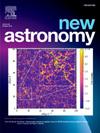Solar energetic particle transport via the heliospheric current sheet: Evidence of a ground-level response on All Saints Day, 2014
IF 2.1
4区 物理与天体物理
Q2 ASTRONOMY & ASTROPHYSICS
引用次数: 0
Abstract
We investigate the physical mechanisms responsible for the solar energetic particle (SEP) event observed on 1 November 2014, during which several ground-based detectors in both hemispheres, specifically those located on the sunlit western side of Earth, recorded simultaneous enhancements in counting rates. The event is attributed to Active Region (AR) 2192, one of the most active sunspot groups of Solar Cycle 24, which at the time was situated near the western limb of the solar disk, approaching the far side of the Sun. A plausible scenario involves a combination of solar eruptive activity, particle acceleration by a shock wave driven by a coronal mass ejection (CME), and the presence of a heliospheric current sheet (HCS) sector crossing, which may have enhanced magnetic connectivity between the Sun and Earth. We emphasize data from the New-Tupi muon detector, operating in scaler mode and located near the central region of the South Atlantic Anomaly (SAA). The particle excess detected on 1 November 2014 by ground-based instruments spanning different rigidity regimes, in conjunction with satellite observations, indicates that the signal was not a localized phenomenon. Assuming a power-law energy spectrum for the SEP population, we find that its high-energy tail in the GeV range is consistent with proton flux measurements reported by GOES-13. We present and discuss the details of these observations.
太阳高能粒子通过日球层电流片传输:2014年万圣节地面响应的证据
我们研究了2014年11月1日观测到的太阳高能粒子(SEP)事件的物理机制,在此期间,两个半球的几个地面探测器,特别是位于地球阳光照射的西侧的探测器,记录了计数率的同时增强。这一事件归因于活跃区(AR) 2192,这是太阳周期24中最活跃的太阳黑子群之一,当时位于太阳圆盘的西翼附近,接近太阳的远端。一种可能的情况包括太阳爆发活动、日冕物质抛射(CME)驱动的冲击波导致粒子加速,以及日球层电流片(HCS)扇区交叉的存在,这可能增强了太阳和地球之间的磁连性。我们强调来自New-Tupi介子探测器的数据,该探测器位于南大西洋异常(SAA)的中心区域附近,工作在标量模式。2014年11月1日,跨越不同刚性体系的地面仪器结合卫星观测检测到粒子过剩,表明该信号并非局域现象。假设SEP粒子群的能量谱为幂律,我们发现它在GeV范围内的高能尾巴与GOES-13报告的质子通量测量结果一致。我们提出并讨论这些观察的细节。
本文章由计算机程序翻译,如有差异,请以英文原文为准。
求助全文
约1分钟内获得全文
求助全文
来源期刊

New Astronomy
地学天文-天文与天体物理
CiteScore
4.00
自引率
10.00%
发文量
109
审稿时长
13.6 weeks
期刊介绍:
New Astronomy publishes articles in all fields of astronomy and astrophysics, with a particular focus on computational astronomy: mathematical and astronomy techniques and methodology, simulations, modelling and numerical results and computational techniques in instrumentation.
New Astronomy includes full length research articles and review articles. The journal covers solar, stellar, galactic and extragalactic astronomy and astrophysics. It reports on original research in all wavelength bands, ranging from radio to gamma-ray.
 求助内容:
求助内容: 应助结果提醒方式:
应助结果提醒方式:


